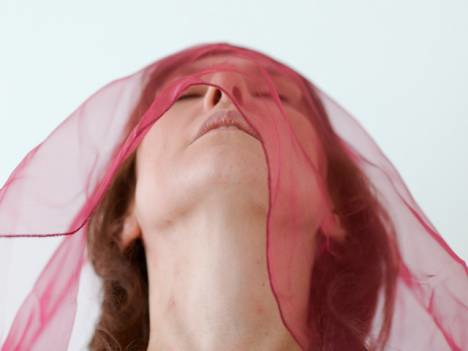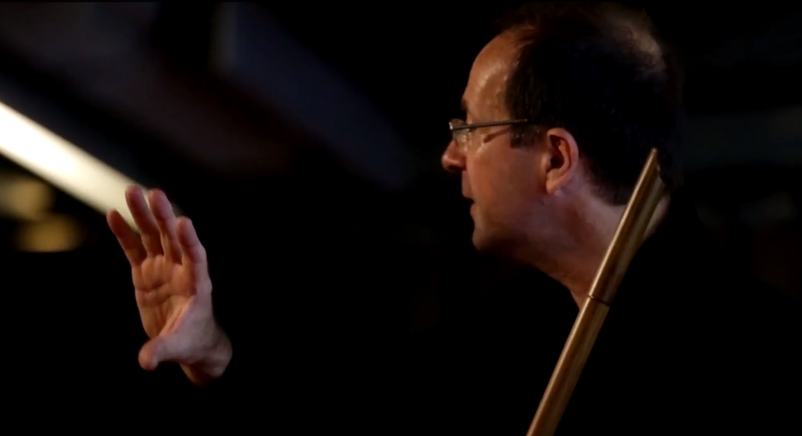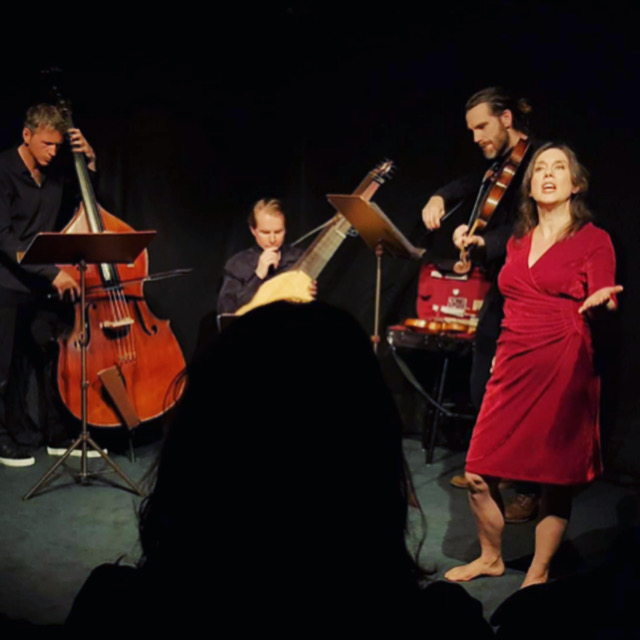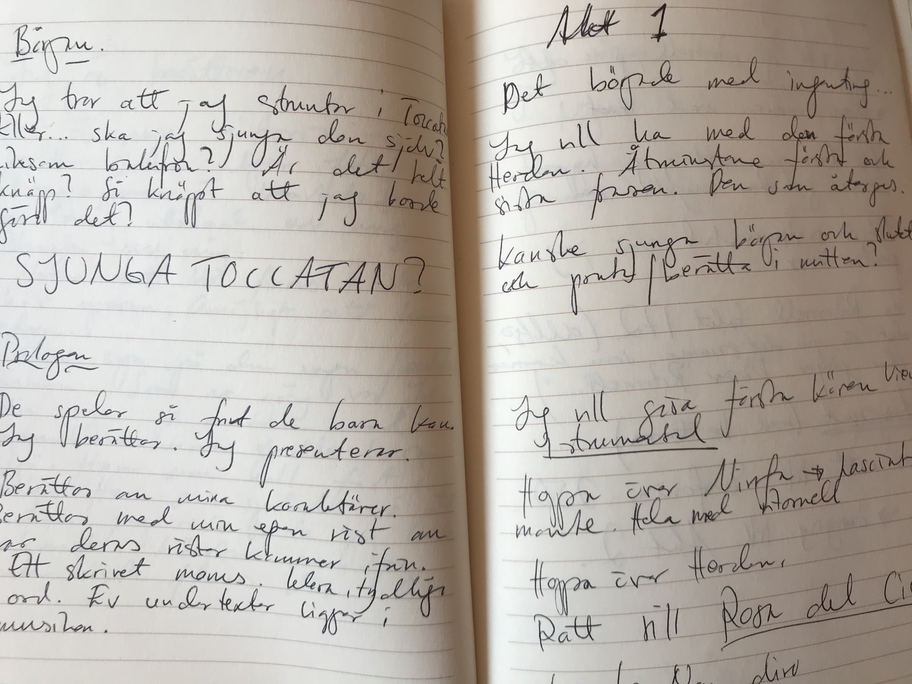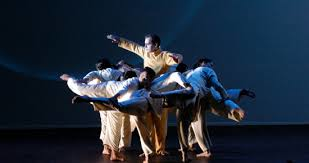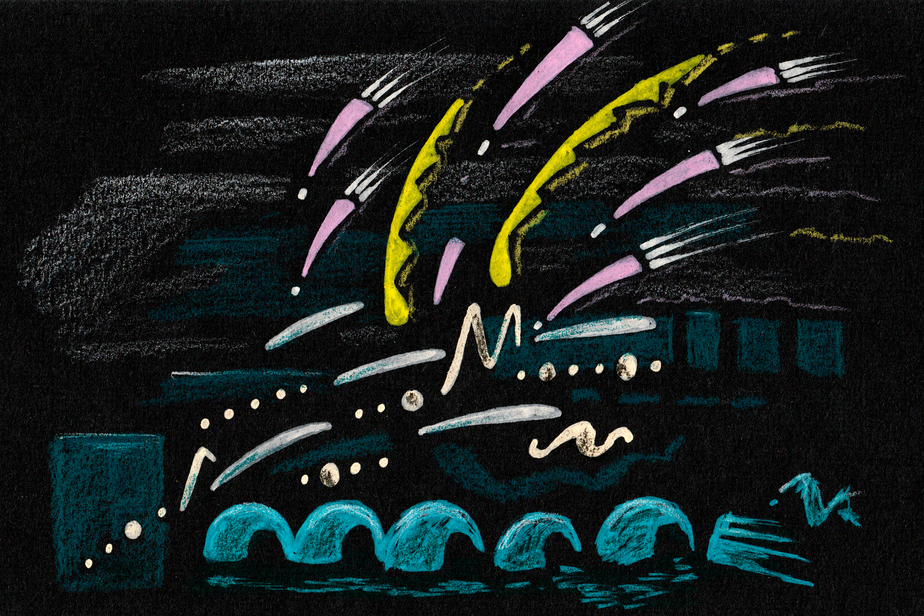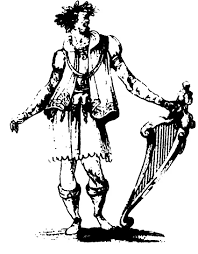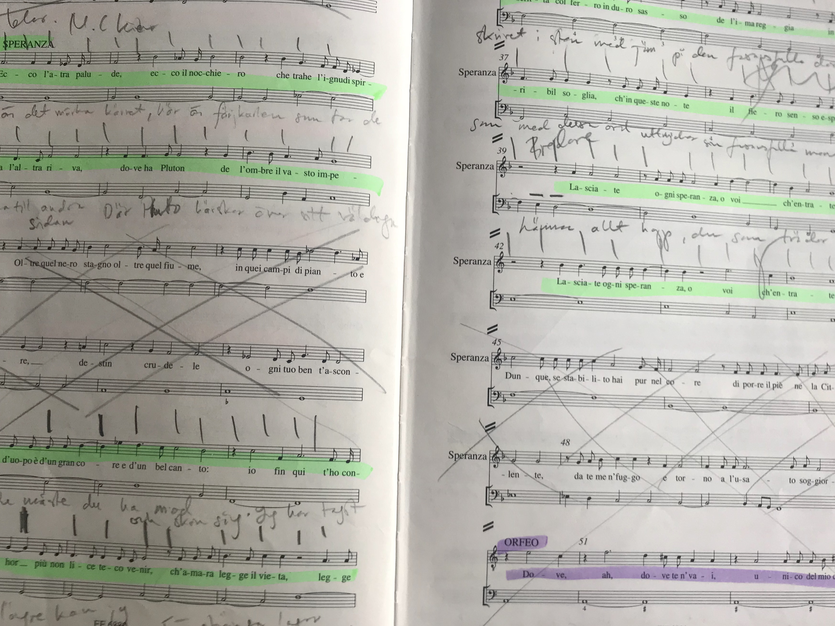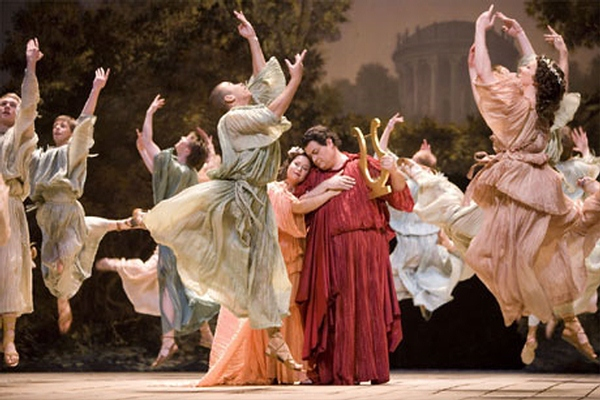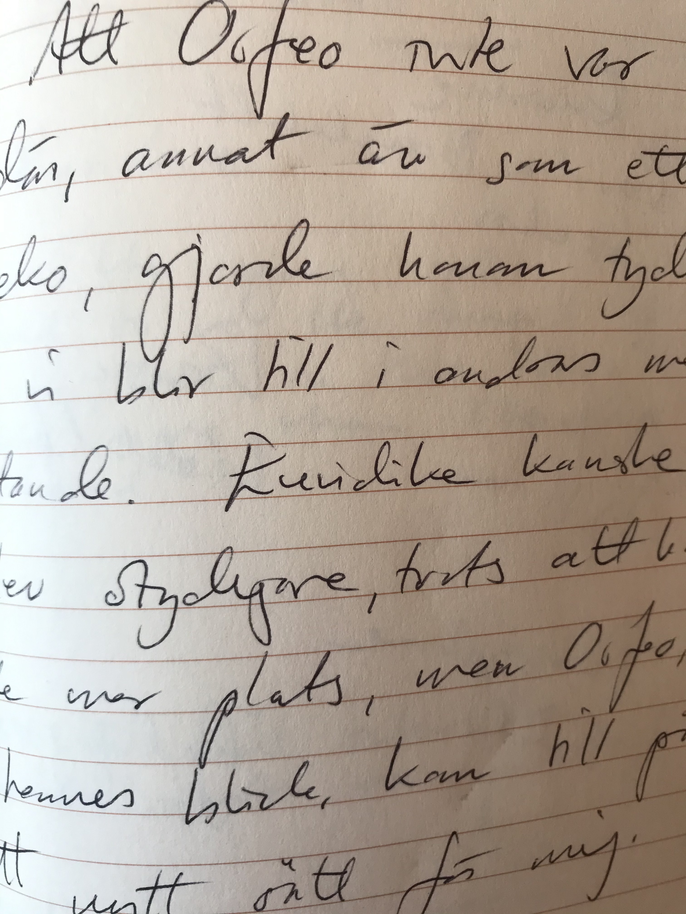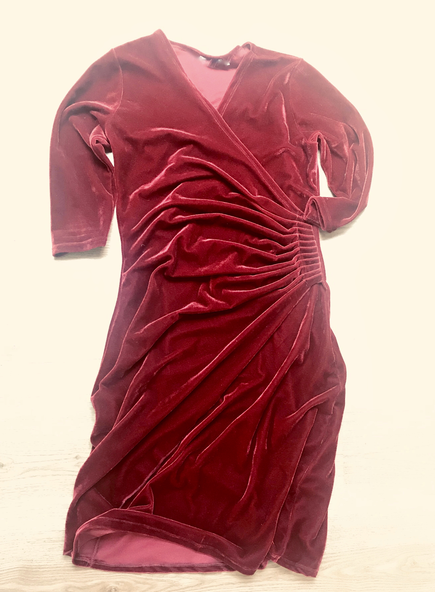Reading Il Corago
”Perhaps we assume that those early stagings simply happened, growing plant-like out of the highly charged atmosphere of some courtly camerata or the camaraderie of the musical equivalent to an up-market commedia dell’arte troupe…But there is also evidence for the existence of a distinct and self-sufficient functionary in certain theaters of the period: a functionary whose role had at least something in common with the modern stage director’s, though he might have elements about him of the 20th-century impressarion, movement coach, dramaturg and stage-manager as well. He was known on occasion as the choragus or corago…”FN
The Corago was the one who made theatre performances and spectacles run smoothly. Today she/he is replaced by: the stage manager, the stage director, orchestra director, artistic director…
Some of The Corago’s tasks would include:
To make sure the actor-singers are in their costume before the performance and that the musicians have tuned their instruments (”because it is unpleasant to hear an instrument being tuned while people are singing and playing”). He must also make sure that all machines are well ”soaped or oiled” (”…for it is most unbefitting to see a man come on in the midst of things to handle a machine (as happened at the wedding of the most serene Duke of Parma)”)
”Il Corago" is also a treatise from ca 1630 with useful notes on how to behave on stage as an actor-singer.
How to use gestures: ”Since acting in music moves at a slower pace than spoken acting, it is necessary that gestures likewise moves more slowly, so that the hand does not stop before the voice.”
How, and when, to walk ”If in acting generally one must avoid walking while speaking (especially walking quickly), all the more must one avoid it when singing, since singing is noticeably altered and spoiled by motion.”
How to phrase music: ”One should not sing uninterruptedly, even though there is no pause in the musical score. Singing must stop briefly at every break in the sense, and the player may sometimes stop as well. Sometimes he may linger on the same note, and at other play a particular and distinct music - provided singer and player have rehearsed thoroughly together in advance.”
How to pronounce text: ”Words have to be uttered distinctly, the last syllables in particular, because hearing only the voice and the change of vowels, not the distinct articulation of the syllables, much offends the ears of the listeners, or at least the most expert of them.”
These quotes give me today, information on how serious it should be standing on a stage. It reminds me that everything I do counts. The audience will be another, with other references and tastes than in 1630 (as are my own), but my presence and my respect for the art itself is the same.FN
This book, by the anonymous author is one of the very few remaining sources on staged performances in the 17th-century, and the interest for Il Corago has increased over the last decade. E.g. Andrew Lawrence-King has an ongoing project with the aim to incorporate the principles of Il Corago in his productions (one of which I, myself, have participated in - Dido&Aeneas by Henry Purcell, although that was produced with more moderate use of Il Corago FN)
I have it in my mind when reading modern texts on stage art by Wiklund, Fischer-Lichte, Grotowski, Brook et.al.
Being Il Corago!
Normally, I am a singer, and more, a Classical singer, which means that I have been brought up to do what I am told every time I practice my art. I’ve met many wonderful coaches, conductors, producers and stage directors who have had opinions on who I am and how I best serve music. We are part of a strong tradition, and bearers of a cultural inheritance, so this is unavoidable, nonetheless not always desirable if you’re a strong headed soprano.
Now, I have been the Corago of this performance. I have been in charge of the dramaturgy, the staging, the costumes, the musician; the Mise en Scene - the transformation of words and music and myself, into magic. It is (at least for me being on stage) magic when it all comes together, making Contact!, and what we can’t explain in words…it just happens!
I needed tools to bring me further away from a normal concert situation, and into another world - to stop time. Erika Fischer-Lichte puts it beautifully:
” mise en scene and aesthetic experience. Both are closely linked to the process of re-enchanting the world and transforming the performance’s participants.” FN
Choosing Storytelling as the staging
- The storyteller’s art of theatre.
”Before the written language existed, there were no stories. There were only storytellers. In the memory of these storytellers there were memories of stories, and it was these memories that the storyteller told. The storytellers remembered a lot of strange things, and not only stories they had heard, but also what they had seen and experienced, and not least what they themselves had thought. All the knowledge the storyteller had acquired through her life was stored in her memory - in her head as well as in her body - as memories.”FN
It started in the workshop with Roger Westberg when he asked me to tell him the story of Orfeo, over and over again. First, I told it as if it had been a movie I had seen in the cinema. It was hard in the beginning, I stumbled over the words, forgetting names and events. But little by little I could tell him about Orpheus and Euridice with confidence and gusto!
After this I used this technique in every conference- and symposium presentation I did and these academic settings became my fora for the Favola of L’Orfeo. Each time some things changed, transformed or got mixed with my own memories and experiences. Suddenly I had done it so many times that it became an essential part of my work. I had found a way to grip hold of my story within the story.
By bringing this method into my project, the story of Orfeo kept changing, being constantly renewed and recontextualized. I got to play with the sounds and bodies of the characters in an un-selfconscious, playful way.
Later in the process, it would become the way I would present the material in the final production. There is such a lot of drama going on in the opera that I wouldn’t be able to act out on stage without losing my mind (all that dancing, dying, seducing would take the breath out of the best of us). Telling this as a story, would do away all the extra action.
Wiklund says about the first greek dramas (the very same spectacles that the academies in the renaissance/early baroque wanted to see re-born), that it seems that apart from the choir, there was only one actor on stage at the time. An actor, who didn’t act or perform, but simply told what was going on around them.
”People are killed and murdered in horrible ways, they kill themselves, stick out their eyes, etc. But none of this is shown on the theatre stage. It's just being told about it. By a storyteller.”FN
Thus, using storytelling as a method and technique actually brought me back to the greek drama - the renaissance dream!
Wiklund also argues that theatre and staged drama in the 17th-century consisted of actors making speeches more than acting as we know it today:
”There are many indications that the art of acting in the official Western European theater was more like speech art than theater art, as we understand it. It was like this until the end of the 18th-century. The acting team speaks on the theater stage. But in these speeches they used the technique of playing roles, prosopopoeia.”FN
Prosopopoeia
1 a figure of speech in which an imaginary or absent person is represented as speaking or acting
2. Personification.FN
Does this mean that my personal interpretation of the storytelling method had brought me back again to the 17th-century stage?
Getting impulses
In all the stagings I’ve mentioned above the singers have other singers to connect to. In this performance, you don’t have anyone to play against. You have to find the feedback loop in yourself. How does one do that? Singing or acting with others automatically gives you you artistic gifts in the form of unexpected impulses, or friction, which provide warmth and fire. Maybe even frustration which will make you work harder to make yourself clear. This other person might also give you a slide to blissfully glide down. In this show, you have to do that almost all by yourself.
”The character, the singer, the composer, the writer or poet, the director, the coach and the sound engineer - even the designer - all have their own voice, yet ultimately it is the performer’s voice we apparently hear. When the voice itself seems divided into separate voices for singing or speaking, the various possibilities of ”ownership” are not merely increased by one bur are in fact doubled.” (Parker and Huesca FN)
Apart from ”the composer, the writer, the poet” (who are always with us), there is the audience, the room, the expectations, which will create a feedback loop for you and the audience. Erika Fischer-Lichte writes about how we receive energy, information, and impulses from everything around us. How it meets us, is thrown back to the audience and our co-actors, and makes one story become as many as there are individuals in the room. ”The energies released from the rhythmic movements and speech circulated between actors and spectators created a reciprocal release and intensification of energy. These energies then collided and resulted in the ”struggle” between chorus and audience.”FN
How could I find strategies to get that energy I normally get from others, this time from myself and from the characters? By giving myself impulses I hadn’t experienced in the rehearsals. I already described how I let the characters ”surprise me with their sudden entrance”, after my moments of stillness and nothingness. But it could also be as simple as leaning my weight on different feet or making gestures I normally do with the right hand with the left instead, and through that, creating this desired imbalance or a ’struggle’. It could also be suddenly singing new ornaments, changing dynamics, or phrasings. Anything, really, that gave me new impulses and energy.
The actor is the one who remembers. And the storyteller remembers. The body remembers and the voice lives in the body. This particular Actor-Singer’s body also remembers all the voices she has heard singing this music. All the L’Orfeos, Messagieras, Proserpinas and shepherds from Jean-Pierre Ponnelle’s version to Trisha Brown: they were there with me; singing with me; correcting me; giving me new ideas…
Besides, I had ”The tree with a name” as well as L’Orfeo to react to. The film by Wolfgang Lehmann and me, which first served as ”Prologo”, and then broke the opera up and mirrored me on the big screen, providing a co-actor with myself.
When all this is said, of course I wasn’t alone with myself, the characters and my own private memories; I had Ensemble Odd Size. As always, they gave me energy and the friction needed to start a fire, and the coolness to stay focused. They surprise me with ideas (and sometimes with mistakes) born that very same second.
Chapter 8
- Mise en Scene
Or, finding ways to stage L’Orfeo as a Singer, Actor-singer, Musician and Il Corago, and ending up reconnecting to the source of the late renaissance- early baroque opera!
Scene one, act five. Euridice is lost and Orfeo has returned to Trachea, heavy with sorrow and self-loathing. The only one speaking to him now is Echo - she who loved Narcissus. Echo answers Orfeo by repeating the last syllables of each phrase he sings. Calcagno writes: ”At this crucial moment the demigod is able to overcome his narcissism only on the condition that he face the acoustic mirror of himself, his ”pure identity” confronting Echo’s ”pure alterity.” Calcagno argues that this scene in one of the most critical in the opera. Illustrating Orfeo’s pure self, and how he’s losing it.FN
My reason for cutting it (and this is my very personal opinion. It could have been a terrible mistake! Maybe I should have left it?!), is because it doesn’t help with the narrative - it doesn’t bring it forward. Instead, it digs into Orfeo’s self-love, self loath, loneliness, and anger, and we’ve already seen that (and we will see more of it later in the scene.). In my version, the narcissistic perspective is still overwhelmingly clear; it’s me, and it’s me, and it’s me. I am Orfeo. Orfeo is Me. Orfeo, son Io. ”Echo” is everywhere in the opera, just in disguise as other characters, and in myself.
When writing this, I recall a performance I did of L’Orfeo with Gabriel Garrido and Ensemble Elyma. It was, I believe, in 2001 at the Festival Oude Muziek Utrecht. Being part of the chorus, I had had a break for a long time at this time but was getting ready to get on stage for the final chorus (omitted in my version). Suddenly one of the solo tenors gasps and get all white. He had forgotten to do the Echo. Just a few notes, but, according to Calcagno, vital to the entire opera. It all went so fast, and I only recall us all laughing uncontrollably. I’m thinking about it now. Orfeo crying out to…No one. No one hears him. The story was spontaneously re-written that evening.
What is new?
The only truly experimental part of the performance is that it is an opera, normally with a cast of at least seven, now performed by only one singer. This one singer - casting is of course also gender-neutral. In the premiere, all roles were sung by men, and here one woman portrays them all! (I could say that is experimental enough in itself…)
Apart from that, it is a traditionally narrated story. No abstract elements or advanced choreography. I do see Ponnelle, Høxbro, Westberg and a little bit of Grotowski in it, but not so much Trisha Brown this time.
So.
It’s not really storytelling. I am in fact singing a written text but using a format inspired by orally education storytellers.
Neither is this Commedia dell’Arte, while there are also elements and ideas from that.
It's not physical theatre, although I am using my body, creating figures.
It is not Cruel theatre (Although Hanne said it might have recognisable elements of Artuad in it.).
It is not an experimental opera with abstract gestures and I do not change the narrative to create an alternative and contemporary storyline.
It is not HIP staging with baroque gestures and big costumes.
(However it is HIP because I’ve chosen a ”speech-like” presentation of the music. I always address the audience directly, speaking to them.)
And, It is mine.
The Poor, Pure, theatre? The Pure, Poor, voice?
Doing it, the baroque way would require machines, wigs, tons of costumes, horses…! You could do that. In some cases that would even make your life easier, because the audience would have too many spectacular and fantastic things to absorb, to pay attention to You and your struggles. It would also make it easier in the sense that you’d have help from the outside to form the characters and the scenes. If you change the costume or use different props, the audience will see that you are someone other than two seconds ago, so you won’t have to make as strong shifts from within.
I played with the expressions ”La voce pura” (the pure Voice) and ”Poor theatre”. Not only does ”pura” and ”poor ”sound the same when you pronounce them in English, but it also implies that it’s all there; in the Voice and in the actor. You are the theatre, and You are the Voice.
Hanne Dieserud guided me towards the staged performance. The characters’ music, voices and bodies had been investigated (in chapter 3+5) and now we to put it together into a continuous flow - going from one character to the other in the blink of an eye. When Roger Westberg, in his one-man/stand-up Shakespeare, makes these transitions he often choses to spin around, and in the turns of the body he adjusts his mind and body to the new character. It is a method that is clear to both himself and audience. Also, it looks great, like a dance on stage.
Charlotte Engelkes, in ”Miss very Wagner”, tells us a story in spoken words, describing personalities and their circumstances so that we always know what is happening to whom.
Both methods are effective, fun and quite spectacular.
I had to find another way since I had already chosen not to speak or describe the narrative in any other way than already written in the score.
Poul doesn’t move a lot during a performance. He might turn to pick up a new instrument and he might take a few steps to make a point. Nevertheless, he manages to create a whole performance with as many characters as there are in the stories.
”It requires both practice and a strong mental condition to go from one role to the other in a performance without losing the magic. In the middle of the two roles is the concentration and contact formed by the meeting of the audience.” as he said earlier in the interview.
I decided on the ”Nothing Way”. Seeking the ”Nothingness,” that Belgrano, Calcagno and Barad do.
These moments of stillness, and Nothingness became my most helpful tools. In the Nothingness I’d empty my mind, and only in the very last second my body would find the next person’s specific posture and attitude. She or he would almost surprise me with their sudden presence.
And how much should I form the characters on stage? I already had the music, which we know plays a crucial part as stage director. Ørjan Wiklund thinks I shouldn’t overdo it:
”The storyteller always retains control over his story. She herself chooses which of the roles in the story she plays, and does so only in terms of how well such a way of telling will serve her purpose. She also does not entirely characterize the roles she plays. Only the characteristic features of the character she portrays are significant to what she wants with the story.”, FN
So, I started there. I had previously exaggerated their features and voices in workshops and rehearsals, now I wanted to see what happened when I did as little as possible.FN
Costume
A costume can help our understanding of the role we’re performing; the tight hold of a corset, the smell of a dusty fabric, the sound of something unfamiliar, and the look of a stranger in the mirror (especially when the costume is combined with hair and makeup). More than once have I had an epiphany when the costume comes on, ”so this is who you are.” The movements of the body change, and with that, the Voice, and with that the character. Aoife Monks writes about the importance of costuming the actor in the book ”Actors in Costume:
”In fact, it’s in the porousness between actors and their costumes, and between life and performance, where the interest in costuming lies. By thinking about costuming we can imagine theatre as a contradictory place of illusion where audiences can look at real clothes. We can think about the dress of the audience and the actor, and consider the actor’s role in the fashion system. We can consider the power of costuming to shape identity and form bodies. Costuming can also invoke the audience’s deeply complicated act of looking at the surface, but rather encourage us to look beyond, past, or through it to some imaginary internal substance of being.”FN
A costume can both hide and reveal. It can also, like Peter Brook says: ”It is very easy - and it happens quite often - to spoil an actor’s performance with the wrong costume./ If the designer sketches with panache - and if the costume is beautiful in its own right - the actor will often accept it with enthusiasm, only to discover weeks later that it is out of tune with all that he is trying to express.”FN
I could have had one costume, or one gadget (a hat, a veil, a scarf…), for each character, but then the costume would have helped me and the audience too much (as with the machines and horses discussed earlier). I could have forgotten that it is My Body and My Voice that have to do the work.
Dramaturgy, staging and cuts!
As described in chapter 2, I told this story of Orfeo -to understand it myself and to convey it to others. This way, I found a way to understand my story within the story, so to speak. I put this under ”dramaturgy” because it gave me a dramatic structure that I could use when sculpting the opera in a way that provided space for both story, music, the characters, the musicians, and myself. When I sat there with the scissors in my hand, ready to cut out all I wouldn’t use, the dramaturgy and the story was clear: I left everything I told as the storyteller, and got rid the rest. I will come back to the storytelling in a minute!
Because the music and the libretto are so connected in the early 17th century opera, the cuts I made followed the music almost seamlessly.
Poor Theatre:
Looking to Grotowski and his expression ”Poor Theater”; ”theater freed from everything that kills it”. Where you can’t hide behind curtains or costumes, but have to embrace the nakedness. ”The acceptance of poverty in theatre, stripped of all that is not essential it, revealed to us not only the backbone of the medium, but also the riches which lie in the very nature of the art-form”.FN
With this in mind, Hanne Dieserud and I chose a red velvet dress to dress them all:
Orfeo in a red velvet dress; Euridice in a red velvet dress; Caronte in a red velvet dress…
Thus stating the obvious: I am Elisabeth. And I, Elisabeth, have to sing through them, and the Voice is the Persona. Me and my and my body language have to take on the roles even of the costumes.
I started with watching as many staged versions I could find on the internet, in the library and on my bookshelf. How had others done it before me?
The legendary Ponnelle/Harnoncourt L’Orfeo from 1978 takes us to a burlesque 17th-century court with strong connections to Commedia dell’arte. He, Ponnelle makes the singers act - sometimes at the expense of the voice.
In Brown/Jacobs the narrative is found in abstract gestures and dancelike movements. Deflo/Savall paint renaissance tableaus with beautiful dancing, light and colours. (Jordy Savall looks like the re-incarnation of Claudio Monteverdi.)
Musically, these productions can be placed in the main stream HIP field, and in my ears, the singers sound more or less the same from each other. With a 21st century approach -classically trained, some with more, some with less knowledge on baroque singing. However they are wonderful.
There are other productions I’ve studied where the most experimental lies in the music - as the adaptions by Kats-Chernin (Komischer Oper Berlin 2012) and Hans Ek (Wermland Opera 2015), but since the music plays such a big role in the opera that their personal interpretations of it changes the whole story. Kats-Chernin creates a both fierce and ambivalent Orfeo full of fire and passion. Ek paints a painful picture of Orfeo, black and bleak.
Both of these versions (and I have already mentioned them in the chapter about music, nr. 3) let the performers sing in their mother tongue (German/Swedish) which naturally alters the musical structure. The melodic Italian is exchanged with crisp German and Swedish.
All of them are lavish, full of scenography and gorgeous costumes. I would have loved to copy each and every one of them into my project. Instead, I went back to a source closer to Monteverdi.
”…when we propose to the actor that he should transform himself before the spectator’s eyes using only his inner impulses, his body, when we state that the magic of theatre consists in the transformation as it comes to birth …” Grotowski FN
Danish Poul Høxbro is one of the storytelling musicians I mentioned in chapter 2 (libretto). I asked him a few questions to see if I had been on the right track. Høxbro’s specialty is medieval stories combined with music, and he switches between speech and music. I wanted to know how he prepares: how he finds his own voice, and how the speed of shift effects him. Text in parentheses are reflections of my own.
Elisabeth: Do you go between different roles when you first play (the musician) and then tell stories (the storyteller)?
Poul: Definitely. For my personal part, there is a big difference between musical vs. verbal communication. But let me also point out that my primary role in a performance situation is always the musician. I never stand in a situation where the narratives have to carry my entire performance; they are always supportive of the music.
No matter how expressive, virtuoso and outgoing I interpret a piece of music, it requires me to turn most of my concentration inward. It may not look like that on stage, but the more I can mentally shut out, the stronger the communication of the music becomes. As through a small but very concentrated beam. Quite the opposite with my verbal communication. Here I must be open to all channels, transform my communication from the concentrated, almost introverted, to an embracing extrovert.
The story is found inside me as in a single point and must come out almost like an explosion, where the music is found around me and is conveyed just as strongly (hopefully) in an artist's implosion.
(The big difference for me, is of course that I present the music and the story simultaneously. I changed the roles within the story, but stayed the same actor-singer-storyteller-musician the whole time. Feeling the beam and the explosion of the story and the implosion of the music. Or the opposite?)
(I’ve constantly changed roles in this project - not only the ones in L’Orfeo, but also between singer, musician, artistic researcher, administrative secretary etc- and I am trying to find ways of enrich them, instead of fighting them.)
P. It requires both practice and a strong mental condition to go from one role to the other in a performance without losing the magic. In the middle of the two roles is the concentration and contact formed by the meeting of the audience. It must be constant, and it is this that guides me almost unconsciously or improvisational and makes the music and the words balance in each performance.
E. I am a singer and musician exploring new ground as a storyteller. The story and the words are already in the music so I could just sing the words and the notes that are written there, but I wish to convey them in the role of the Storyteller. The words and the music are, in my case, entwined.
What do you, as a musician (who I mainly know you as) get out of the stories?
P. They give me a sense of security in my dissemination of that which is musically abstract. This is to be understood in the way that I often play and convey music that is unknown and foreign to most audiences. The stories help to create images that not only support the tones, but almost set in motion a personal mini-opera inside each individual listener. It thus creates an expanded understanding without me having to turn off, or on, the poetic stream through a performance by having to make tedious factual breaks.
(personal mini-opera, poetic stream, creating images, expansion… yes. I understand this.)
E. Do you act when you tell stories?
P. Like most storytellers, I use first and foremost what I want to define as ”my own voice”. That is, my voice without major distortions. After all, this is my main instrument when I narrate, and just like with my other instruments, I make use of the whole spectrum of my voice, sonorous as well as dynamic and with pitch tempo. Some rare and carefully selected times I can then introduce a "different" voice to break the pattern or for extra attention, but it must be done very sparingly, as I do not act, but tell my story.
(Do I tell MY story? I shouldn’t, but of course I do. The storyteller remembers, and, again, the actor is the one who remembers…FN Even though I didn't intend to, the story of Orpheus/Orfeo/Orfevs did become mine.)
(Monteverdi helps me a little bit by adding so much of himself into the story. His interpretation is the constant…fragrance/taste/colour. And that helps me to go away from my own self and what I perceive as my story.)
E. As you know, I have the music by Monteverdi and some basic instructions written in the score, such as Caronte’s very heavy bassline and his low and insisting vocal line, or Proserpina’s gliding, seductive melody over the jazz-like bass. These ”instruction”s invite certain ways of using my voice and I have also experimented with standing in different ways (leaning on one foot, slouching, almost throwing myself on the ground etc) and felt my voice changing with my movements.
Do your voices come as a consequence of how you stand when you tell them, or do they come from the story? Characters?
P. Yes and yes. I have stood in a room with 6-800 listeners and had to tell a story in Danish, Swedish, English or German. In such cases, the situation will provide very special conditions for the rear listeners to be able to understand every word without the ones in the front being blown over. My nuance possibilities are narrowed, but within the new boundaries I must then be able to differentiate so that the magic is kept throughout the story anyway. An intimate cafe concert of course offers completely different possibilities and challenges.
But the story can also set the tone for your voice. Is it a sad story? A beautiful poet? A bizarre and comic story? I will always use my voice to create an instant mood for the upcoming narrative. But I can also choose to cheat the audience and break a mood…
Illustration borrowed from Andrew Lawrence-King's website for his project "Il Corago"
La Voce Pura
”La Voce Pura” is anything but Poor. Calcagno offers following description of the phenomena Venetian17th-century phenomena: ”…the magnification of singer’s vocal abilities to such an extreme as to efface, if only momentarily, word meaning.”FN Or ”When” as Elisabeth Belgrano says (and which I understand with all my heart), ”nothing matters more than a voice streaming out of me, reaching into infinity.”FN
Hence, the Pure voice can express Everything and Nothing.
Karen Barad says: A cacophony of whispered screams, gasps, and cries, an infinite multitude of indeterminate beings diffracted through different spacetimes, the nothingness, is always already within us, or rather, it lives, through us”FN
Needless to say, I couldn’t tell this story the way a storyteller like Poul does, I had a score with text and music to follow. I didn’t switch between musician and storyteller - I was the storyteller (although not as experienced as Poul) and the musician simultaneously. But, I used the format and the idea!
It might seem like an easy way out, but as Poul said, it required a lot of focus, concentration, subtlety and presence. I didn’t want to do too much, but still I wanted to present Orfeo’s story, and it had to be understood.
Ensemble Odd Size (in this production)
From left:
Johannes Lundberg - Dubble bass
Fredrik Bock - Lute /baroque guitar
Per Buhre - baroque violin, baroque viola.
Audi/Tragicommedia - looks like a classic theatre play about a biblical story.
And the latest from the Neederlanse reisopera and Director Monique Wagemakers, choreographer Nanine Linning and artist Lonneke Gordijn who have created an abstract narrative with flowing figures and movements (and primal screams after Euridice’s death!).
